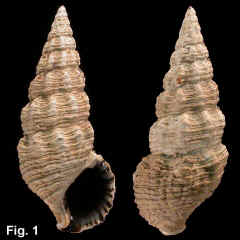|
|
BATILLARIIDAE |
|
|
Batillaria australis (Quoy & Gaimard, 1834) Description: Shell sculptured with coarse axial ribs, extending from suture to suture on early whorls, but restricted to upper portion of whorl on latter whorls, and occupying only top quarter on body whorl; spiral sculpture of primary and secondary ribs, thickened where crossing axial ribs; coarsely beaded below periphery of body whorl. Outer lip slightly flared, slightly thickened in adults, with anterior canal and shallow posterior sinus. Aperture lirate within except in very mature shells. Exterior colour brown, sometimes with a white spiral band. Columella fawn, interior of outer lip purplish-brown with black lirae, or with white callus in very mature shells. Operculum circular, corneous. Size: Up to 49 mm in length, typically 30 mm. Distribution: Endemic to Australia; Whitsunday Islands, Queensland, southwards to Victoria and Tasmania. The species died out in SA in the Pleistocene, and fossil shells are occasionally encountered (Ludbrook, 1984). In WA, it occurs in only two populations - the Swan River estuary and Cockburn Sound - which Wells and Bryce (1986) suggest were established by human introduction. Habitat: On mud flats in estuaries, river mouths and mangrove swamps. Locally abundant. Comparison: Adult specimens of B. australis are readily distinguishable from Pyrazus ebeninus, by being smaller and having a less flared outer lip. Juveniles can be separated by details of sculpture, spire angle and colour as described by Ewers & Rose (1966). Remarks: This species is one of the hosts for the flatworm parasite Austrobilharzia. Larvae of the flatworm are discharged from the snail into the surrounding water. They normally burrow into the legs of wading birds and complete their life cycle, but may burrow though the skin of humans, causing "bathers itch", but they cannot survive in a human host. (Ewers, 1965) Larval development of this species has been described by MacIntyre (1961). The life cycle of the adult was investigated in Narrabeen Lagoon by Ewers (1963). He found that breeding takes place in summer, with most snails breeding for the first time at the end of their second year. Many die during the third year, with most not surviving the fourth year. Fig. 1: Tuross River, NSW (C.315210) |
||
